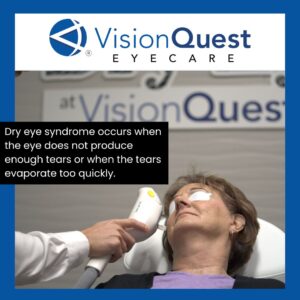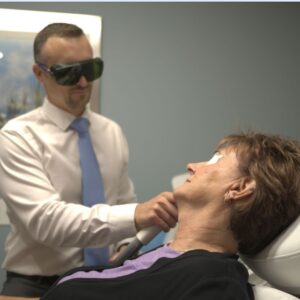Dry eye syndrome, a common yet often debilitating condition, affects millions of people worldwide. Characterized by a persistent lack of adequate lubrication and moisture on the eye’s surface, dry eye can cause discomfort, visual disturbances, and a higher risk of eye infections. Fortunately, recent advancements in dry eye treatment offer promising solutions to alleviate symptoms and improve the quality of life for those affected. VisionQuest Eyecare, with locations in Greenwood and Fishers, Indiana, remains at the forefront of these innovations, providing cutting-edge care tailored to individual needs.
Understanding Dry Eye Syndrome
Dry eye syndrome occurs when the eye does not produce enough tears or when the tears evaporate too quickly. This condition can be triggered by various factors, including aging, hormonal changes, environmental conditions, screen time, and certain medications. Symptoms include redness, irritation, a gritty sensation, and blurred vision. While traditional treatments like artificial tears and lifestyle changes can offer relief, they may not address the underlying causes of dry eye.
Advanced Diagnostic Techniques
At VisionQuest Eyecare, accurate diagnosis is crucial for effective treatment. Advanced diagnostic tools such as tear osmolarity testing, meibography, and LipiView® are used to assess tear film stability and gland function. These technologies provide a comprehensive understanding of the patient’s condition, enabling tailored treatment plans.
Tear Osmolarity Testing measures the salt concentration in tears, helping to identify the severity of dry eye.
Meibography visualizes the meibomian glands, which produce the oil layer of the tear film, revealing any blockages or atrophy.
LipiView® assesses the tear film’s lipid layer, providing insights into tear evaporation rates.
Innovative Treatment Options
- LipiFlow® Thermal Pulsation LipiFlow® is a breakthrough treatment for meibomian gland dysfunction (MGD), a leading cause of dry eye. This in-office procedure uses a combination of heat and gentle pressure to unclog blocked glands, restoring the natural flow of oils into the tear film. LipiFlow® is FDA-approved and has been shown to provide long-lasting relief from dry eye symptoms.
- Intense Pulsed Light (IPL) Therapy Originally used in dermatology, IPL therapy has been adapted to treat dry eye. It works by reducing inflammation and improving the function of the meibomian glands. IPL therapy targets abnormal blood vessels that contribute to inflammation, enhancing tear production and stability.
- Amniotic Membrane Therapy Amniotic membrane therapy involves placing a biologically active tissue graft on the eye’s surface. This treatment promotes healing and reduces inflammation, making it effective for severe cases of dry eye and corneal damage. The membrane contains growth factors and anti-inflammatory properties that accelerate recovery.
- Punctal Plugs Punctal plugs are tiny devices inserted into the tear ducts to block tear drainage. By retaining natural tears on the eye’s surface longer, they help alleviate dry eye symptoms. Punctal plugs are available in temporary and semi-permanent options, allowing for customized treatment.
- Prescription Eye Drops Several prescription eye drops have been developed to address the underlying causes of dry eye. Cyclosporine A (Restasis®) and lifitegrast (Xiidra®) are two commonly prescribed medications that reduce inflammation and increase tear production. These drops target the immune response contributing to dry eye, providing significant relief for many patients.
Lifestyle and Home-Based Solutions
In addition to in-office treatments, VisionQuest Eyecare emphasizes the importance of lifestyle modifications and home-based solutions to manage dry eye. Recommendations may include:
- Humidifiers: Using a humidifier can add moisture to the air, reducing tear evaporation.
- Hydration: Drinking plenty of water helps maintain overall body hydration, including eye moisture.
- Screen Time Management: Following the 20-20-20 rule (taking a 20-second break every 20 minutes to look at something 20 feet away) can reduce digital eye strain.
- Eyelid Hygiene: Regularly cleaning the eyelids with specialized wipes or solutions can prevent gland blockages.
- Nutritional Supplements: Omega-3 fatty acids have been shown to improve tear quality and reduce inflammation. Supplements or a diet rich in omega-3s can benefit dry eye patients.
The VisionQuest Eyecare Advantage
Choosing VisionQuest Eyecare for dry eye treatment means benefiting from a holistic approach that combines advanced technology, innovative treatments, and personalized care. The experienced team of optometrists and ophthalmologists at VisionQuest Eyecare is dedicated to staying abreast of the latest developments in eye care, ensuring that patients receive the most effective and up-to-date treatments available.
Dry Eye Treatment
Dry eye syndrome, though common, can significantly impact daily life. Innovations in treatment are transforming the management of this condition, offering hope and relief to those who suffer from its symptoms. At VisionQuest Eyecare, patients have access to state-of-the-art diagnostic tools and cutting-edge therapies that address both the symptoms and underlying causes of dry eye. Whether through advanced in-office procedures or personalized home care recommendations, VisionQuest Eyecare is committed to enhancing eye health and improving the quality of life for every patient.
For those experiencing dry eye symptoms, scheduling an appointment with VisionQuest Eyecare in Greenwood or Fishers, Indiana, is the first step toward effective relief and long-term eye health. Visit VisionQuest Eyecare to learn more and book your consultation today.

Dr. Terry Null is an optometrist and co-founder of VisionQuest Eyecare. He helped found VisionQuest Eyecare with principles of kindness, compassion, and excellent service in 1997. With expertise in dry eye, Dr. Null is dedicated to helping others.



